Listen:
Scroll down for a transcript, how to subscribe, and more
Welcome to Episode #26 of Habitual Excellence, presented by Value Capture.
We are joined by Kedar Mate, MD, President and Chief Executive Officer at the Institute for Healthcare Improvement (IHI), President of the IHI Lucian Leape Institute, and a member of the faculty at Weill Cornell Medical College. We are also joined by Patricia A. McGaffigan, RN, MS, CPPS, Vice President, Safety Programs, Institute for Healthcare Improvement (IHI), previously served as COO and Senior VP of Programs at the National Patient Safety Foundation until 2017, when the Foundation merged with IHI.
In this episode, our host Mark Graban asks Kedar and Patricia about the IHI National Action Plan to Advance Patient Safety, how this is connected to the late Paul O'Neill, and the connections between workforce safety and patient safety. We also chat about the IHI National Forum and how that is a virtual event this year.
Other links:
- To Err is Human (report)
- Safer Together (report)
- IHI Lucian Leape Institute
Video:
Quotes:
!["[IHI] was founded on the concept that we could take methods that were developed largely in manufacturing and in industrial engineering — methods of quality and safety — and translate them to healthcare settings."](https://www.valuecapturellc.com/hs-fs/hubfs/Imported_Blog_Media/1-Sep-06-2021-03-53-00-84-PM.png?width=940&height=788&name=1-Sep-06-2021-03-53-00-84-PM.png)
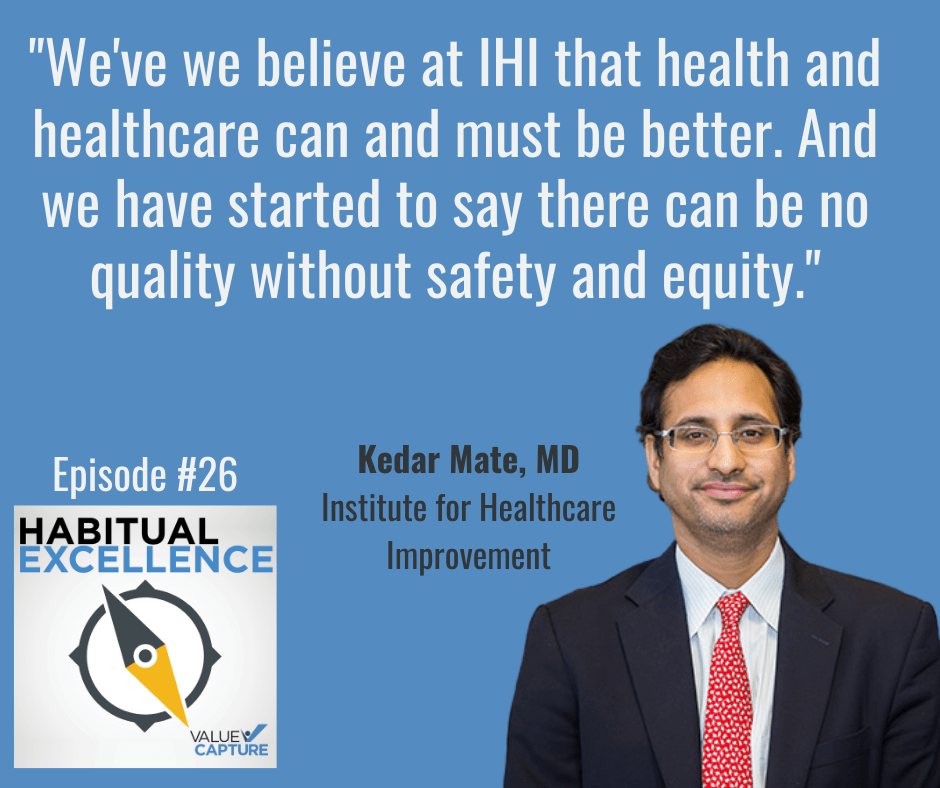
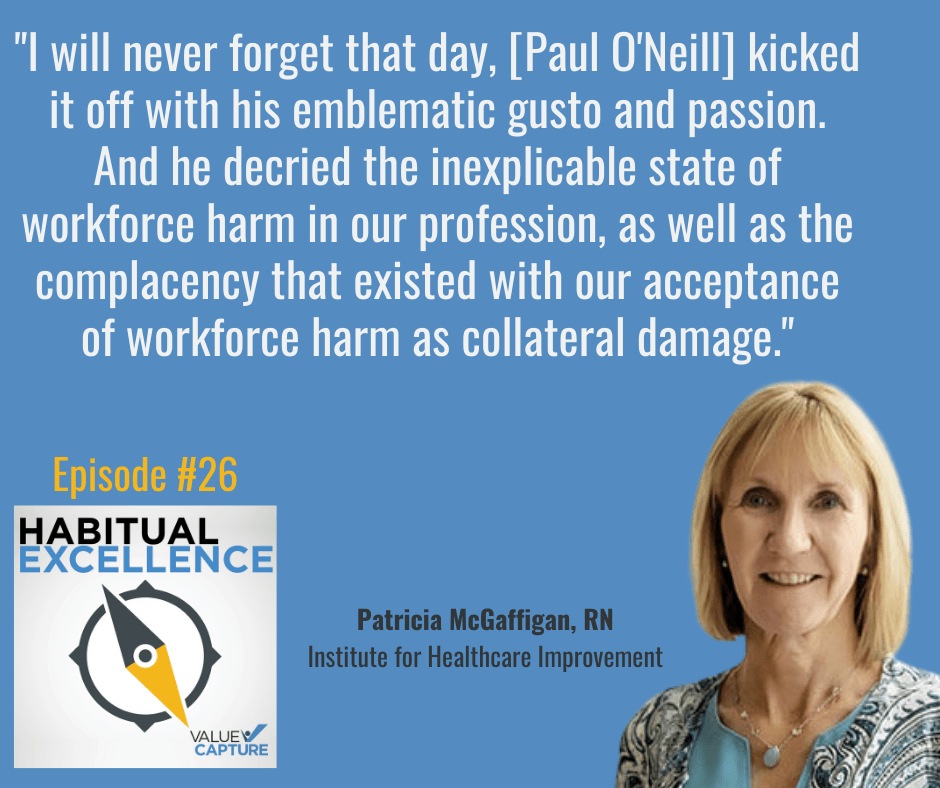
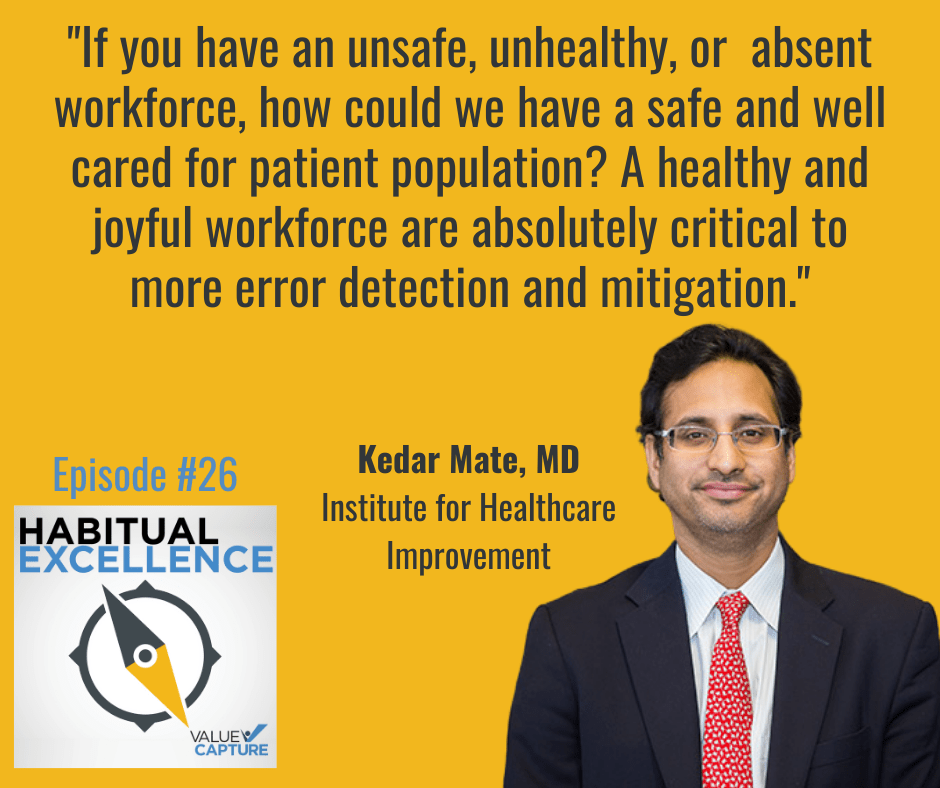
Click to visit the main Habitual Excellence podcast page.
Subscribe:
To make sure you don't miss an episode, be sure to subscribe today! Please rate and review the podcast.
Transcript:
INTRO (2s):
Welcome to Habitual Excellence presented by Value Capture. This podcast and our firm is all about helping you and your organization achieve habitual excellence via one unifying focus, one value based structure and one performance system. In other words, it's about helping you capture dramatically more value through achieving perfect care and perfect safety for patients and staff. To learn more about Value Capture and our services, visit www.valuecapturellc.com.
Mark Graban (36s):
Hi, welcome to Habitual Excellence. I'm Mark Graban. We're joined today, we have two guests joining us from the Institute for Healthcare Improvement or IHI as they're often referred to. We're joined by Kedar Mate. He is the president and CEO, and we're also joined by Patricia McGaffigan, vice-president of safety programs. How are you?
Kedar Mate (58s):
Good.
Mark Graban (58s):
Thank you. Great. Yeah, well, thanks. Thanks for joining us. But before we get started, you know, Patricia, if you can first introduce yourself and tell the audience about your professional background and your role at IHI.
Patricia McGaffigan (1m 12s):
Sure Mark, and thanks for having us on today. As you noted, I serve as the Vice President of Safety Programs at the Institute for Healthcare Improvement, and I've been at IHI since our merger with the National Patient Safety Foundation, where I previously worked three years ago. At the National Patient Safety Foundation, I had been there involved in many years of work on advancing safety, and it's kind of created an opportunity for us to be where we are today talking with you with our combined efforts on safety. As I look back at my career, some of the things that stand out as being pretty notable are the diversity of the things that I've done as a nurse, both in clinical practice and academic settings and working in a variety of roles in startup and established medical device companies.
Patricia McGaffigan (2m 3s):
But the common thread that I've had across all of this, Mark, has been my focus on safety and my passion for safety. So I would say that that's the common denominator that brings me to where I am today and the most happy places that I find myself in, in this work on safety, include things like meaningful engagement of patients and families, safety of the healthcare workforce, initiatives that are more transformational in safety and some which we might talk about today, including our think tank and our national action plan for patient safety and safety as a driver of value.
Mark Graban (2m 42s):
That's great. So that's going to be one of our main themes for the conversation here, of course today, not just patient safety and as we'll get into later, connections to provider safety or employee safety or whatever ways we might describe that. So thank you, Patricia, and thank you again for being here. Kedar, if you could do the same, if you could tell us about your background and for listeners who don't know about IHI, you know, kind of maybe talk a little bit about the history and mission of the organization as well.
Kedar Mate (3m 12s):
Well, let me add my thank you to you Mark, and to your audience for joining us here. We're so thrilled to be on this program with you, and I'm glad to be joined by my colleague, and, Patricia, as well in this, in this time together. So a bit about me. I'm a, I'm a physician, I'm an internist. I have a faculty appointment at Weill Cornell Medical College in New York, but for the past 10 years or so, I've worked at the Institute for Healthcare Improvement. I've played a lot of different roles for IHI over that duration. I've worked a lot in global health at work in our program in Africa, and our helped build our efforts in Asia and the Middle East, along with serving for a long time now on our R & D or what we call our innovation team where I was the Chief Innovation Officer until this new job, which began in the summer this year, mid-pandemic as it were.
Kedar Mate (4m 7s):
So that's a bit about me. I've had a long, my career has been mainly in health, social justice, quality now over the last decade or so, and an emphasis as Patricia had noted on patient safety and on health equity. So those are kind of the themes if I had to say in my, both in my research career, in my clinical practice, and now in my work as a, a leader and manager here at IHI. IHI has been and has been around for about 30 years. It was founded in the early nineties and it was founded on an innovative idea. It was founded on the concept that we could take methods that were developed largely in manufacturing and in industrial engineering methods of quality and, and, and safety and translate them to healthcare settings.
Kedar Mate (4m 60s):
And in the first effort, back in the late eighties and early nineties, the National Demonstration Project that Don Berwick, who was the founder of IHI, along with Glenn Gottfried and others ran a demonstration project where they, where they partner 20 industrial leaders with 20 health systems. And they, the industrial leaders who have been well steeped in quality methods and quality improvement methods taught the health care organizations, those methods, they coached them through, problem solving methods and techniques, and they apply those things to safety issues in the operating room, safety issues on, in the emergency room, waiting times, various challenges and defects that our systems still suffer from today.
Kedar Mate (5m 43s):
And they found amazing impacts, you know, declines in error rates, declines in waiting times, improvements in patient experience and so on so much so that the IHI was born in effect as a result of that project because other health care it to learn those same methods. And ever since then, we've been applying those methods in large health systems and small communities all over the planet in 30 countries now, all of which is seeking to improve health and healthcare worldwide. We've we believe at IHI that health and healthcare can and must be better. And we have started to say, there can be no quality without safety and equity.
Kedar Mate (6m 25s):
And we strongly believe that the improvement, science and methods, and we do believe that to be a science that continuously evolves and matures and develops, that that science can drive real meaningful patient outcomes and results. So it's a again, pleasure to be with you and happy to take any other questions you might have on, on that or others.
Mark Graban (6m 46s):
Yeah, well, it, it probably merits in an entire episode and discussion on its own, the, the questions of equity and social justice and connections to health care. I think a lot of times when we think of patient safety, we often think of, let's say preventable errors, a medication error that causes harm to a specific patient. And, but when it comes to equity kid, or if you could just even touch briefly, maybe just elaborate a little bit more on that, the state of inequity and, and how that connects to healthcare quality and outcomes.
Kedar Mate (7m 20s):
Well, there's been, I mean, there's been numerous reports now, I won't belabor that kind of science and data on this, but for in 2003, the Institute of Medicine wrote a report that followed two areas. You've been crossing the quality chasm called unequal treatment in which they chronicled all of the inequities that were present in our system, many of which had existed for centuries before and had subsequently issued for the continued for the decades since. So there's plenty of data that documents the disparities and the inequities that are present in our health and healthcare and health, health service delivery. And certainly in the outcomes that we all experienced as a society, as a whole.
Kedar Mate (8m 0s):
And the notion here is that it's hard to imagine a high quality or high performance or highly reliable system that systematically excludes a third of the beneficiaries or a half of the beneficiaries, as we're now seeing in many environments. And today, if you look at the largest causes of excess mortality, mortality, and morbidity in our healthcare environment, that's amenable to healthcare solutions most of that is driven by inequities, by black, white disparities, by rural urban disparities and so on. So if we take a, and you know, the tools that we have and the quality of diverse of improving reliable system delivery, reducing unnecessary and wasteful variation, those same tools could be used and deployed to resolve this unnecessary, unjust, inefficient source of variation that we don't really need or want in our system.
Kedar Mate (9m 1s):
And what we've shown now over the last three or four years, when we reached this realization about five years ago at IHI, that we could use the very same methods and tools and techniques that we use to improve safety. We could be using them to tackle problems of inequity. And when we started to do that first with eight health systems, and now with 24 others, which we're presently doing, who are pursuing equity initiative, we found unsurprisingly just as we did with patient safety, that when you take a disciplined, proactive approach to the problem of unnecessary undesirable variation, guess what you can make it better! And we're finding the same thing with the kinds of inequities that we're experiencing to be clear, we're not solving or ending racism, but that is, but we are starting the process of untangling, how our systems are built and architected in a way that produces these kinds of inequities.
Kedar Mate (9m 55s):
And we are addressing along the way, some of the, some of the causes of the causes as others have said, which include structured racism and injustice.
Mark Graban (10m 4s):
Okay. Well, thank you for your work on all those fronts out oil in the show notes, make sure we have links to those reports that you mentioned. So Patricia, turning back to you, can you tell us about what's called the national action plan to advance patient safety? What, what that is?
Patricia McGaffigan (10m 23s):
Sure. And let me give you a little bit of context for why we're even asking the question about the national action plan Mark. About 15 years ago, excuse me, about 15 years after the publication of To Err Is Human, we were curious whether or not we had really made any meaningful progress in safety. And to that end, we convened an expert panel. And that panel determined that in fact, while we had made progress, particularly in some circumscribed areas, such as hospital acquired conditions that overall we had not yet meaningfully move the needle on advancing safety in the way that we needed to, and the harm rates were still deemed to be unacceptably high.
Patricia McGaffigan (11m 4s):
We also didn't have a strategy that national strategy that To Err Is Human called for and was repeated in crossing the chasm was repeated in the recommendations of this expert panel. And that was to develop a coordinated and collaborative approach to advancing safety. So as part of the merger between the National Patient Safety Foundation and the Institute for Healthcare Improvement, IHI committed to doing something about that. And we established the National Steering Committee for Patient Safety or NSC as we frequently refer to it. And the NSC was charged with the creation, the dissemination and the monitoring of a national action plan that would meaningfully advance patient safety.
Patricia McGaffigan (11m 47s):
So just about five weeks ago, and after about two years of really intensive collaboration between the 20 members of the National Steering Committee, we did release "Safer Together: A National Action Plan to Advance Patient Safety." And the National Steering Committee built the action plan around four foundational areas that were deliberately chosen because they'd been deemed essential for ensuring safety across the continuum of care, no matter what project we might be working on these four areas matter. And they include culture leadership and governance, patient, and family engagement, learning systems and workforce safety. Now across those four areas, we provided 17 recommendations that relate to the four foundations.
Patricia McGaffigan (12m 34s):
And we also developed two other resources that include a self-assessment resource, which is designed to help leaders and organizations determine where they currently are in advancing their safety work and to set goals for progress. And that's also supplemented with an implementation resource guide, which details some of the tactics and supporting resources that people can use once they take that assessment tool and develop a plan for action. So we think the National Action Plan is really vital and unique because it's the first initiative of this kind in this country where we have seen this degree of coordination and collaboration of stakeholders. And it really raises the bar on what we believe our expectations around safety and pushes the envelope to focus on those four foundational areas, which have often been very overlooked as we've taken on those specific improvement projects in safety.
Mark Graban (13m 32s):
Well, well, again, again, also make sure that there's a link to that Safer Together publication for the audience to go and check that out and take a deeper dive. And you also want to explore if, if you would Patricia, some of the connections to the late Paul O'Neil who was, you know, a leader within Value Capture and, and more broadly when it comes to, you know, leadership and culture and safety is, as you were saying.
Patricia McGaffigan (14m 5s):
Sure. I think those connect connections are incredibly deep and meaningful, Mark. Paul served on our Lucian Leape Institute, which is regarded by many as the most acclaimed think tank in patient safety. I think in the world and in 2012, Paul served as co-chair for expert round table on workforce safety. And in fact, my very first day of work at the national patient safety foundation was the day of this round table. And Paul, literally the first person I met beyond the staff of my new organization. I will never forget that day, he kicked it off with his emblematic gusto and passion, and he decried the inexplicably state of workforce harm in our profession, as well as the complacency that existed with our acceptance of workforce harm as collateral damage.
Patricia McGaffigan (14m 54s):
And part of doing business that was acceptable, which was so far away from Paul's realization that theoretical limits of zero were at the place that we really needed to be. So the resulting report and recommendations that Paul led were, I believe one of the most foundational milestones and advancing workforce safety and health care. And it served as the basis for so much of what we've done to date. Now, the connection here ties to work for safety, but I really think it's so much bigger than workforce safety in and of itself, because as you just mentioned, Paul was, and he embodied so much around those foundational areas that we're talking about specifically when he looked at the things that we have to tackle to be habitually excellent.
Patricia McGaffigan (15m 42s):
They cover all four of those areas. And I can hear Paul saying right now that we have to be sure every day that we're focused on getting to habitual excellence or the foundations, because if we don't, no matter what we do, we're just not getting it right. And I think that's one of the sad lessons learned with our progress and safety to date that we have not focused in on those essential areas where habitual excellence is so vital and essential. And I think Paul would probably say, unless we're doing that, we're failing in our moral duties to eliminate harm to patients and to the workforce. So all in all, when I think about the connections, I can feel Paul and the words that he would say, and the lessons that he would share that are just so foundationally relevant for what we've developed with this National Action Plan.
Mark Graban (16m 35s):
Yeah. Well, thank you Patricia, for sharing that and, and Kedar, turning back to you what are your, some of your thoughts on those connections between workforce safety and patient safety?
Kedar Mate (16m 51s):
Well, they absolutely go hand in hand, of course, the report that Patricia describes the National Action Plan chronicles, a, the notion of a total systems of total system safety, the idea that you really can't have a safe patient population without a safe and healthy caregiving population and workforce, if you have an unsafe, unhealthy, or indeed absent workforce, how can you, or how could we have a safe and well cared for patient population? A healthy and joyful workforce are absolutely critical to more error detection and mitigation.
Kedar Mate (17m 30s):
So unless we give the people that work in our care environments, the necessary respect, so it's both a physical safety as well as psychological safety, so it's both the necessary respect, support, and resources. They would be more likely to not be able to follow, you know, safe care practices and they'll, they won't be able to work well in teams and that will lead to errors. Such a workforce would also be important and would be meaningful to patient engagement and to improving patient engagement. So these two things really go completely hand in hand here as described in the report. Another question might be how to, how to manage it, how to do it, how to improve it, how to strengthen workforce safety at this time.
Kedar Mate (18m 14s):
And I think that we're experiencing the challenges today in the middle of this pandemic of what happens when we threatened the workforce significantly due to the very real threat of COVID, as well as the existential threat of not minding the safety of the workforce? So we have to pay attention to staff shortages, to cognitive distraction, to overload, use of the electronic record, as well as the specific aspects of the helping healthcare workers protect themselves from chemical, infectious pathogens, et cetera, in the care environment. Interventions that are available to us, we have knowledge now, we have a evidence-based now around how to handle patients more safely, how to prevent slips and falls, how to avoid things like needle stick injuries, how to work a PPE and how to acquire PPE and prevent exposures there's nascent and, and building work around how to prevent violence in the work environment.
Kedar Mate (19m 14s):
There's unfortunate a rise in such events is we all read about in the newspapers and there's evidence to suggest this is on the rise. So there's more evidence as growing around how to put in a set of practices that would prevent violence from occurring in the workplace, as well as ways of building psychological safety. IHI has written a lot on this latter point around psychological safety and building what we call a joy in work and workforce resilience and wellbeing. And that may be of interest to the viewers and listeners here. Again, there's a theory attached to that, of how to go about building that kind of workforce resilience and wellbeing.
Mark Graban (19m 55s):
Well, thanks. And, you know, Patricia, you know, speaking of interventions, what are some of the actions that come from the National Action Plan? You mentioned recommendations and a self-assessment. Can you elaborate on what some of those kind of, you know, practical steps might be?
Patricia McGaffigan (20m 17s):
Absolutely. So, first of all, the National Action Plan is really targeted at ideally healthcare executives and those who are leading safety and quality. So those are not the only audiences, but they are the primary audiences for the National Action Plan. And this is where the incredible relevance, I think, of the recommendations and the suggestions for improvement come into play. So we'd encourage people to review those materials and to be able to discern how that can really create some in the work that folks are doing right now to advance safety. I would boil the actions on the action plan down into three areas, Mark.
Patricia McGaffigan (20m 58s):
And the first one is really around reviewing the plan itself and the related materials to be able to identify what some of those recommendations are, and also to be able to appreciate some of the rationale for the recommendations. Secondly, the self assessment tool is something that people can use to evaluate where they stand in each of those foundational areas, and to be able to determine what their priorities are for improvement. And then the use of the implementation resource guide is something that helps people determine whether or not there could be some tactics and approaches, many of which are well-established as Kedar alluded to an evidence-based that can help them advance that progress.
Patricia McGaffigan (21m 43s):
Now, a good example, I think of what this might look like could be around workforce safety. So let's say we have an organization that is fairly advanced and progressive in workforce safety. They've already hired hard-wired many, many practices, and they are definitely on a good, a good path to eliminating harm. There are still opportunities that can exist. So one of the things that might be called into question for somebody who's at a more advanced level of workforce safety would be things like, so is workforce safety embedded not only in what you're doing right now, but in your long-term strategies, including your succession plans, because we see so much of what's going well in safety can sometimes be disrupted when some of those leaders and others transitioned in their roles.
Patricia McGaffigan (22m 35s):
So that would be one example. Another example would be whether or not you're able to identify, monitor and address workforce harms from inequities. And this ties to what caterer described earlier, where, and by the way, when we develop the National Action Plan, we developed principles for the work of the national steering committee. And that commitment to eliminating harm from equity was one of the most important principles that guided the work of the National Steering Committee. Another example would be how can you use your current state of maturation and continue to help others grow as you engage in learning networks, which is an area that I know was again so important to Paul.
Patricia McGaffigan (23m 19s):
And I guess I have a final thought overall on this work. And that is that no matter what is in the National Action Plan that relates to any of the four foundational areas or domains, and I can hear Paul telling us, like, don't just do it because it's there, but invoke the spirit of who he was from a continuous learning and improvement perspective and Kedar has talked about the criticality of that as well. And making sure that we have this habitual and collective lens and capability to advance safety.
Mark Graban (23m 55s):
So I'm sure again, you know, there's a lot that everyone can dig into the safer together publication and we'll we'll point people to that in the show notes. So maybe one final topic here, the National Forum, the IHI National Forum held every December's and event that I've attended. A couple of times, it's always very energizing and informative, but because of the pandemic, as, as most organizations are do doing there, there were some changes this year. So Kedar, if you could tell us what's different, what approach you're taking with the national forum this year.
Kedar Mate (24m 33s):
Oh, sure. I'm happy to, and thank you for bringing it into the conversation. I want to say that the National Action Plan and all of it's in the work of the National Steering Committee will be featured in the national forum this year, but you're right. It's different this year, as it has to be in an effort to protect our workforce as it were, because we don't want our workforce getting on planes and trains and buses and cars to try to make their way to Orlando, where we typically have the national forum, a gathering of the size that we usually have is probably not advisable during the pandemic so we're not going to do that. We're going to have this entirely virtual. We, we have an amazing program that we build.
Kedar Mate (25m 12s):
We have over 200 presenters that are going to be presenting in 65 sessions that span the four days of the meeting. We have 14 pre-conference workshops, and we're doing something a little different with the keynotes this year. You've probably heard from a lot of the usual kind of healthcare leaders and so on in the, on keynote stages in conference programs, because it's all very easy now to do virtually. So you've heard from a lot of the usual suspects, I think, in, in various ways. So we decided to do something a little different with the keynotes this year. We invited for individuals to reflect on what on one question.
Kedar Mate (25m 55s):
And that question is what would be the health creating system of the future? In other words, as we get past this pandemic, what will the health creating system in the future look like for all of us? And we invited folks who are really out of discipline in the tradition of an innovation kind of organization. We asked an artist and activist chef. We asked someone who's worked in technology and urban planning and those kinds of areas to comment on this. So we have a very interesting group, a very interesting lineup of speakers. Jessica Matthews will speak to us. Who's an entrepreneur and engineer described yourself as a mix between bill Nye, the science guy, and Beyonce, who's created some really interesting and exciting innovations will tell us what she thinks about the technology future that will contribute to the health creating system of the future.
Kedar Mate (26m 46s):
Patrisse Cullors, one of the founders of the Black Lives Matter movement will talk to us about how activism will play out in the new system of the future. Roseanne Haggerty, the CEO of community solutions will speak to us about how the pandemic helped us to end homelessness in many cities around the country and indeed around the world, at least temporarily, and what that might create for us in terms of a different way forward. And Jose Andress, the sort of the world famous chef and humanitarian will talk to us about his work on cheffing his way, if you will, to a completely different place. And thinking with us about what health creation would look like from his point of view, Don Berwick will be there, I'll talk to, but there'll be a lot of really interesting, I think additional perspectives.
Kedar Mate (27m 38s):
And workforce safety and patient safety, will be one of it will be two of the anchor nine tracks of the forum. So there'll be plenty of content, both from the National Action Plan and from others that have been working on these topics. In addition to some of the other themes that we've talked about here, about quality improvement, about equity, about addressing cost and value about improvement, science, and leadership. So we would welcome you to the forum, which is in the first week of December, virtually this year.
Mark Graban (28m 8s):
Well, that's great. And maybe just kind of final wrap up question, on the phrase health creating system jumps out, and I'm sure that's very intentional. Can you just touch on briefly? I'm not asking you to give your whole keynote remarks, but the difference between health care system and health creating system, maybe if you each want to share a quick thought as we wrap up.
Kedar Mate (28m 31s):
Yeah, I, so I you're right. It's very, it is a very intentional phrase. You know, the idea here is that the purpose of our enterprise, ultimately the purpose of healthcare is to create better health for our population, for our people, for the people that we have the privilege of serving in different ways. And so, w w if we start from the premise of how do we change healthcare, that's one way of starting a line of questioning. But if we, we start with a more open-ended question about what a system of health creation or health production would really look like that may result in quite a different array or arrangement of supports and services that would enable us to produce better outcomes for people and better health at scale.
Kedar Mate (29m 22s):
And so that's really the point of view that we're trying to understand knowing full well that the bridge from where we are today to that future state might be a, a, a long or mighty bridge to cross, but it is at least directionally. We should know where we're headed, and that's what we're inviting our, our, our speakers to, to, to guide us towards. That's great.
Patricia McGaffigan (29m 42s):
I think that's a critical provocation for us getting to value overall, we're spending so much of our time and energies focused on fixing things versus preventing things and creating that health. And it's not just the physical health of somebody it's the health, the whole being of individuals and communities. So I'm really thrilled at the chance to have us kind of twist things around and to be able to kind of challenge some of the foundations that will be essential for us to be able to do so.
Mark Graban (30m 14s):
Well. Thanks, thanks to the both of you for your leadership on these issues. And yeah, I really want to thank you for sharing a little bit of that with us today and for providing, you know, I think for the audience, a lot of really helpful follow-ups in terms of reports and on the action plan. And we'll, we'll post information about all of that and the national forum, the virtual event in the show notes, we really hope everyone will check that out. So we've been joined again today by Kedar Mate, president and CEO of the Institute for Healthcare Improvement and Patricia McGaffigan again, vice president of safety programs for IHI. Thank you so much to the both of you for being here today.
Patricia McGaffigan (30m 54s):
Thank you. And thank you too.
OUTRO (30m 57s):
Thank you. Thanks for listening to Habitual Excellence presented by Value Capture. We hope you'll subscribe to the podcast and please also rate and review it in your favorite podcast, directory or app to learn more about value capture and how we can help your organization on this journey to habitual excellence. Visit our website at www.valuecapturellc.com.
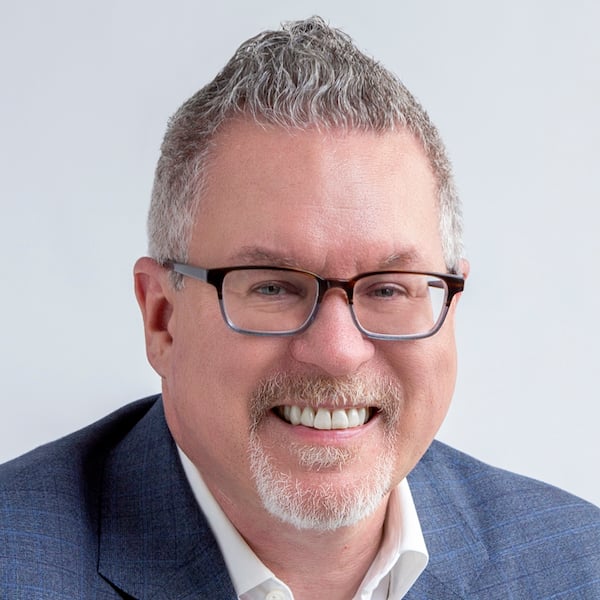
Written by Mark Graban
Mark Graban has served healthcare clients since 2005. Mark is internationally recognized as a leading author and speaker on Lean healthcare. His latest book is "The Mistakes That Make Us: Cultivating a Culture of Learning and Innovation."

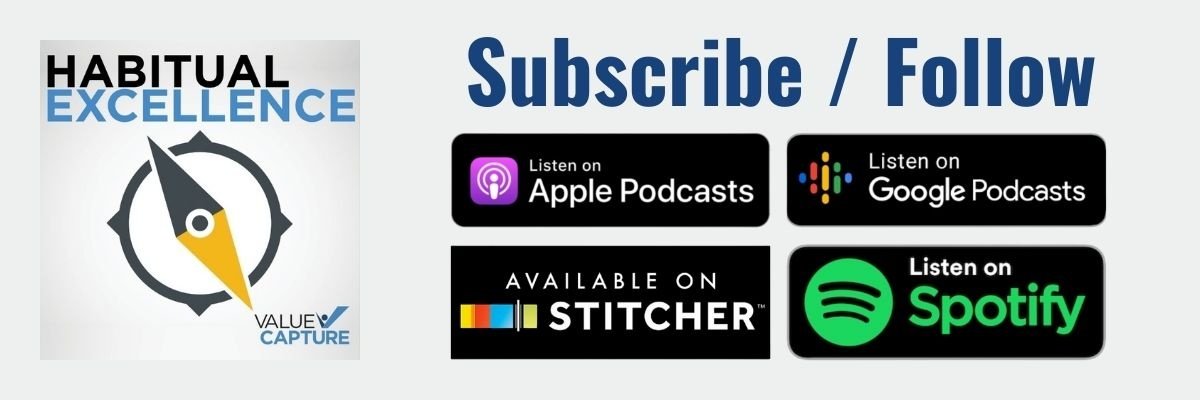
Submit a comment